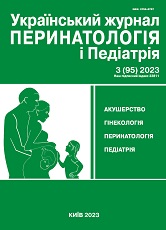Sepsis-associated injury of the nervous system in premature infants with very low body weight
DOI:
https://doi.org/10.15574/PP.2023.95.66Keywords:
premature babies, neonatal brain damage, intraventricular hemorrhage, periventricular leukomalaciaAbstract
The immaturity of the organs and systems of preterm born children significantly complicates the differentiation between physiological and pathological changes in the brain. The etiology of brain damage in premature babies is complex and multifactorial, and even with the most favorable course of the neonatal period, they require additional respiratory support, a large number of invasive medical interventions and have a high risk of infectious complications. Sepsis-associated encephalopathy (SAE) is defined as diffuse or multifocal cerebral damage that is caused by a systemic response to infection even without clinical or laboratory evidence of direct brain infection.
Purpose - to determine the clinical features of sepsis-associated brain damage in prematurely born children <32 weeks gestation with a birth weight <1500 g.
Materials and methods. 38 prematurely born children, who were divided into two groups, were examined. The Group I (n=14) included children who were diagnosed with sepsis in the early neonatal period. The Group II (n=24) included prematurely born, in which no septic lesions were observed.
Results. Children of both groups were born in a state of severe and moderate asphyxia. Analysis of associations between maternal, obstetric, and antenatal factors showed a significant prevalence of such factors as prelabor rupture of membranes, сervical weakness, rupture of the fetal bladder, and placement of an obstetric pessary in children with sepsis. All children with sepsis had pneumonia, acute kidney injury, and brain injury in the neonatal period. In the neurological status of children with very low birth weight who underwent SAE, the seizure syndrome, 3-4 grade intraventricular hemorrhages, periventricular leukomalacia, complications in the form of post-hemorrhagic ventriculomegaly were significantly more common.
Conclusions. In children with very low birth weight who underwent SAE, convulsive syndrome, 3-4 grade intraventricular hemorrhages, and periventricular leukomalacia were significantly more common.
The research was carried out in accordance with the principles of the Helsinki Declaration. The study protocol was approved by the Local Ethics Committee of the participating institution. The informed consent of the patient was obtained for conducting the studies.
No conflict of interests was declared by the authors.
References
Batalle D, O'Muircheartaigh J, Makropoulos A, Kelly CJ, Dimitrova R, Hughes EJ et al. (2019). Different patterns of cortical maturation before and after 38 weeks gestational age demonstrated by diffusion MRI in vivo. NeuroImage. 185: 764-775. https://doi.org/10.1016/j.neuroimage.2018.05.046; PMid:29802969 PMCid:PMC6299264
Chen Q, Yu W, Shi J, Shen J, Gao T, Zhang J et al. (2014). Insulin alleviates the inflammatory response and oxidative stress injury in cerebral tissues in septic rats. Journal of Inflammation. 11 (1): 1-7. https://doi.org/10.1186/1476-9255-11-18; PMid:25093012 PMCid:PMC4108965
D'Apremont I, Marshall G, Musalem C, Mariani G, Musante G, Bancalari A et al. (2020). Trends in perinatal practices and neonatal outcomes of very low birth weight infants during a 16-year period at NEOCOSUR centers. The Journal of Pediatrics. 225: 44-50. https://doi.org/10.1016/j.jpeds.2020.05.040; PMid:32454113
Galinsky R, Lear CA, Dean JM, Wassink G, Dhillon SK, Fraser M et al. (2018). Complex interactions between hypoxia-ischemia and inflammation in preterm brain injury. Developmental medicine and child neurology. 60 (2): 126-133. https://doi.org/10.1111/dmcn.13629; PMid:29194585
Gofton TE, Young GB. (2012). Sepsis-associated encephalopathy. Nature Reviews Neurology. 8 (10): 557-566. https://doi.org/10.1038/nrneurol.2012.183; PMid:22986430
Gong X, Weng B, Zhang X, Yan C, Cai C. (2022). The molecular basis of brain injury in preterm infants with sepsis - associated encephalopathy. BMC pediatrics. 22 (1): 336. https://doi.org/10.1186/s12887-022-03372-5; PMid:35689189 PMCid:PMC9185920
Gunn-Charlton JK. (2022). Impact of Comorbid Prematurity and Congenital Anomalies: A Review. Frontiers in physiology. 13: 880891. https://doi.org/10.3389/fphys.2022.880891; PMid:35846015 PMCid:PMC9284532
Heming N, Mazeraud A, Verdonk F, Bozza FA, Chrétien F, Sharshar T. (2017). Neuroanatomy of sepsis-associated encephalopathy. Critical care (London, England). 21 (1): 65. https://doi.org/10.1186/s13054-017-1643-z; PMid:28320461 PMCid:PMC5360026
Molnár L, Fülesdi B, Németh N, Molnár C. (2018). Sepsis-associated encephalopathy: A review of literature. Neurology India. 66 (2): 352-361. https://doi.org/10.4103/0028-3886.227299; PMid:29547154
Odabasi IO, Bulbul A. (2020). Neonatal Sepsis. Sisli Etfal Hastanesi tip bulteni. 54 (2): 142-158. https://doi.org/10.14744/SEMB.2020.00236; PMid:32617051 PMCid:PMC7326682
Ophelders D, Gussenhoven R, Klein L, Jellema RK, Westerlaken R, Hütten MC et al. (2020). Preterm Brain Injury, Antenatal Triggers, and Therapeutics: Timing Is Key. Cells. 9 (8): 1871. https://doi.org/10.3390/cells9081871; PMid:32785181 PMCid:PMC7464163
Ouyang M, Dubois J, Yu Q, Mukherjee P, Huang H. (2019). Delineation of early brain development from fetuses to infants with diffusion MRI and beyond. NeuroImage. 185: 836-850. https://doi.org/10.1016/j.neuroimage.2018.04.017; PMid:29655938 PMCid:PMC6185831
Van Tilborg E, de Theije C, van Hal M, Wagenaar N, de Vries LS, Benders MJ et al. (2018). Origin and dynamics of oligodendrocytes in the developing brain: Implications for perinatal white matter injury. Glia. 66 (2): 221-238. https://doi.org/10.1002/glia.23256; PMid:29134703 PMCid:PMC5765410
Yap V, Perlman JM. (2020). Mechanisms of brain injury in newborn infants associated with the fetal inflammatory response syndrome. Seminars in fetal & neonatal medicine. 25 (4): 101110. https://doi.org/10.1016/j.siny.2020.101110; PMid:32303463
Downloads
Published
Issue
Section
License
Copyright (c) 2023 Ukrainian Journal of Perinatology and Pediatrics

This work is licensed under a Creative Commons Attribution-NonCommercial 4.0 International License.
The policy of the Journal “Ukrainian Journal of Perinatology and Pediatrics” is compatible with the vast majority of funders' of open access and self-archiving policies. The journal provides immediate open access route being convinced that everyone – not only scientists - can benefit from research results, and publishes articles exclusively under open access distribution, with a Creative Commons Attribution-Noncommercial 4.0 international license(СС BY-NC).
Authors transfer the copyright to the Journal “MODERN PEDIATRICS. UKRAINE” when the manuscript is accepted for publication. Authors declare that this manuscript has not been published nor is under simultaneous consideration for publication elsewhere. After publication, the articles become freely available on-line to the public.
Readers have the right to use, distribute, and reproduce articles in any medium, provided the articles and the journal are properly cited.
The use of published materials for commercial purposes is strongly prohibited.

